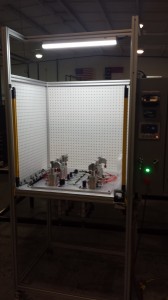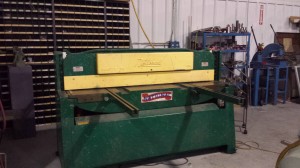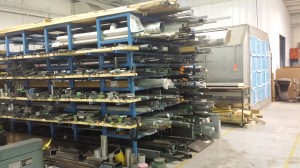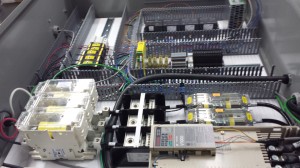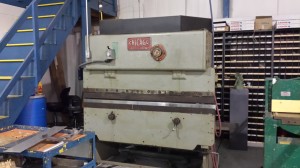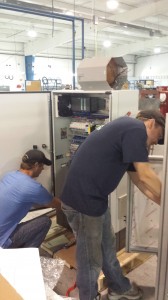Met with Clay a project manager at Mertek Solutions. He has a AS degree in manufacturing, tool machines. He has worked for several automotive and aerospace companies. He communicates with the customer, so he has a lot of customer base ethics/morals, people skills, punctuality and has to quote accurately. The quote value is very important so that they do not overbid and loose the customer or loose company money but do not overbid and loose company money as well. The project managers such as Clay and Mike handle the small to medium sized accounts and leave the larger accounts to Jerry and Jeremy (boss’s son). Clay takes the job start to point X. The engineers (such as Tommy) at Mertek draft unless the company sends them a blueprint of what they want. Clay does some designing. Clay was working on an account for a tractor company in Sanford. He has to design an apparatus that will pick up this and put it on that. EUREEKA-an idea for a lab! It is for an assembly line-which most of the machines built at Mertek are for that purpose. Clay has to be a quick problem solver, to be efficient he cannot have too much trial and error, and the R&D (Research and Development) has already been done. He was going over to the tractor place in the afternoon to look at the apparatus in person. I could not go because I did not have on steel toe shoes nor ear plugs: two pieces of safety equipment they use often. SolidWorks in a computer software program, that I later learned Ed Genova a drafting teacher at JBHS has, clay uses to manipulate the design of the apparatus he needs to build. It is a unit specific (so scaling is important) 3D modeling software. It is important that clay knows the specific heat of the metal he chooses to use, the center of gravity, the fulcrum and lift point for safety. He is striving for function and safety not perfection. These are dxf files. Mertek will keep these plans if the company wants more products, but for now they want 3 of these apparatus. They will use laser cut sheet metal to build it. The name of this project is “Elephant trunk lifting tackle”. 90% of a customer’s cost goes into designing the product. Clay then shows me another software program called Microsoft Project; it is like Excel and allows Clay to but the timeline in for each project. The default for a project is about 24 weeks; however the average project is 10-12 weeks. Projects rarely finish early, some on time, even more a little late by a day or week. Most projects they have to add lots of safety guards and features to keep the people running the machine from injuring themselves. When making things for the auto world they have to check, recheck and recheck due to worries about recalls. They should be getting an fuel injector purchase order this week. Clay then took me in the back to see where the magic happens. 2 machines that are a staple at machine manufactures are the Press Break and Shear. These machines bend and cut metal. I hope to get a picture of these machines asap. There is hot roll and cold roll steel-I need to research more on these to know the difference between specific heat, carbon, nickel, and lead composition.
Met with Cody and Blair. Blair has an exercise science degree but did electrical work in the military. He took PLC (Project Logic Control) programmer classes at CCCC (Central Carolina Community College) that Mertek paid for. Cody has worked in industrial construction and done machine panel work prior to coming to Mertek. These two work closely on most projects they complement each other very well! They showed me a panel build and gave me a several work related acronyms. HMI=Human Machine interface and MCR=Master Control Relay (relay are the switches in the circuit). What you give to machine is the input, what the computer gives you is the output. They were testing the resistance of wire on an oven using current transformers, current inducers, voltage transformers and voltage inducers. These ovens at the customer’s warehouse can cook using both gas and electric which can be a deadly combination. They were using 10,000Volts. Volts are like a punch and can just knock you out Blair explained. But a lot of amps of current can kill you. They were using 0.5amps. He showed me how they have to get things just right in order for it to work, a lot of problem solving and trial and error. Things such the binary code (on or off), light intensity, air cylinder compressors, magnets, etc. Seeing the final product work makes all the hours of hard work pay off.
At our break Henrietta and I discussed our curriculum a little and she came up with the idea that her kids may be able to teach my kids about Ohm’s law and the electrical schematics. Jerry took us out to lunch, a nice family owned Italian restaurant-YUMMY!
Met with Tommy, he is a machine designer. He is very humble and does not like to use the word engineer because he does not have a degree, but he is an engineer J He has been doing his job a long time and says adapting to the new software is just part of the job, it is constantly changing and these youngens need to be adaptable to change. He has used Proengineering, AutoCad and the most recent software Solidworks. That was so amazing seeing him manipulate this 3D computer program between two screens!! He was designing a machine to test the fuel injectors for a leak, a pressure drop. The maximum allowable leak is 0.15cc/min @ 60psi. He had to find the correct size restraints, force and price of everything he added to this machine. Many of the companies they purchase products form had links to drop in the program of the picture of the machine…that sounds weird in words, you would just have to see it in action. Jerry had to figure out the air pressure pushing up and design an air cylinder to hold it down. EUREEKA-an idea for a lab! He had a slide rule that converted English units to Metric that he said he used ALL the time. Tommy told me a fabulous story of how the engineers had to work with the machinists in the back. He said an NC State engineer one time said if I draw it they have to build it, so Tommy told him to go see an old machinist who put him in his place by saying, “I can draw a cow, but that doesn’t mean you can get milk from it!” Every part of the company plays a role into the finished whole product and being organized helps everyone. He said Mertek is the most organized place he has worked for and he loves it! Tommy showed me some cosmetic containers that Mertek solutions made a machine for to pain the insides of.
Tommy took me to meet the welder, David, nicknamed Red due to being a ginger of course. David was a character! He said math was vital in welding, everything is about square and pi and math. He has to check and double check constantly. I asked him about the chemistry involved and whew-MINDBLOWN! There is a 6% difference in C steel and stainless steel. C steel is magnetic. Stainless Steel has low ale and sulfur, making it brittle and hard to work with, 304 and better qualities are non magnetic. I was seeing that I must spend some time researching all this information David was giving to me. He knew his craft! Molten metal and Oxygen will bubble. 3800oF heat to weld, 1800oF will melt steel. It takes 220V of electricity at 100-115A. Carbon dioxide is added to Argon (which is a noble gas and does not react); this shields the metal from bubbling. It is lots of pressure and will act as a torpedo if punctured-so it remains chained down. There are more acronyms: GMACW (?), SMAW (Shield Metal Arc Welding-which is the oldest type of welding with a flame), GTAW (Gas Tungsten Arc Welding-Tungsten doesn’t melt and a lil’ Thorium is added to it), Plasma cutter is newer uses electricity as hot as the sun. I may get to use the Plasma cutter!!: ) EKK!!!!

